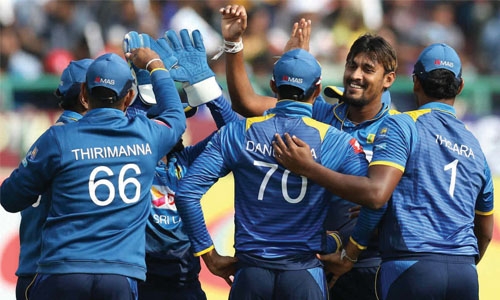Sri Lanka rout India
Dharamsala : Lesser-skilled teams’ best chances of competing are in conditions that skew the balance towards the bowlers - spin or seam. In 26 ODIs in 2017, most of which were played on flat surfaces, Sri Lanka managed to win just four. But in Dharamsala, Sri Lanka’s seamers, led by Suranga Lakmal, used swinging and seaming conditions to rip through a tentative India batting line-up for 112, setting up a seven-wicket rout that also snapped their 12-game losing streak in ODIs.
When Lakmal finished with figures of 10-4-13-4 to leave India at 29 for 7, it didn’t look like the innings would last 38.2 overs. But MS Dhoni shepherded the tail with a calculated 65 to prevent India from the ignominy of falling to the lowest ODI total. Even though India started well in the defence, their total was decidedly under-par as Sri Lanka hunted down the target with 29.2 overs to spare.
In the fresh mountain air of Dharamsala, Sri Lanka’s opening bowlers, Lakmal and Angelo Mathews, repeatedly hit the perfect length: just fuller than good. On a surface with sufficient but not exaggerated lateral movement, that length becomes even harder to negate. Batsmen are indecisive with their footwork and therefore shot selection.
Shikhar Dhawan prefers to dominate bowlers from the outset, particularly with cross-batted strokes. He hung back to Mathews, who angled full deliveries away from his leaden-footed drives. Then, Mathews swerved one back into Dhawan to beat his inside edge, striking him in front of middle. Sri Lanka had umpire Simon Fry’s not-out decision overturned on review to complete the perfect one-two play.
Two overs on, Lakmal hit that ideal length again but with a quicker pace. Rohit Sharma played the line but enough away seam movement kissed the outside edge. This time, Sri Lanka had umpire Anil Chaudhary’s decision overturned.
Most of India’s shots thereafter were borne by an intent to weather that testing period. That resulted in two runs in the first five overs and 11 in the first 10, the lowest in a match involving two Full Members in the last five years.
That also ensured Sri Lanka didn’t need to alter their own approach, as they jagged and nipped the ball both ways. All of Sri Lanka’s first seven wickets were a result of beating the batsmen on the inside or outside edge. Manish Pandey, Hardik Pandya and Bhuvneshwar Kumar were caught behind the wicket off outside edges. Dinesh Karthik fell over a flick and Shreyas Iyer chopped on via the inside edge.
Related Posts

